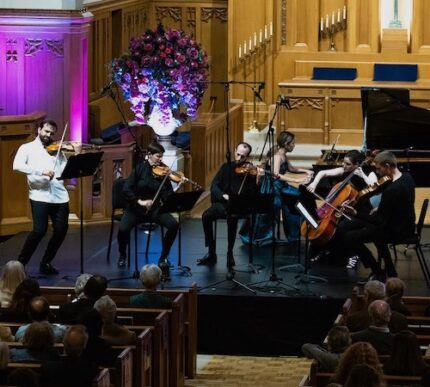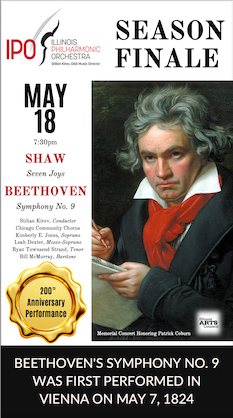North Shore Chamber Fest opens with offbeat rep and a Russian chestnut

On Wednesday night, the North Shore Chamber Music Festival launched its 12th season at its longtime home of the Village Presbyterian Church in Northbrook. Festival stalwarts the Ariel Quartet presided, joined by violinist William Hagen and pianist Janice Carissa.
The program featured one repertoire staple, Borodin’s String Quartet No. 2, bookended by two rarities: a violin-piano transcription of Stravinsky’s Divertimento after The Fairy’s Kiss and Chausson’s Concerto for Violin, Piano, and String Quartet.
The Divertimento is a double adaptation: melodies from Tchaikovsky piano pieces were reworked into a ballet by Stravinsky, who then co-arranged excerpts into a suite for violin and piano with violinist Samuel Dushkin (uncredited in the program).
Hagen played the violin part with a tremendous range of dynamics and colors, especially in the sinfonia, where his tone extended from tremolo-less glassiness to a full-throated vibrato. He brought great rhythmic vitality to the scherzo and the pas de deux’s coda, lending the latter a savagery one associates with earlier Stravinsky.
The piano part (as in the Chausson to come) is a headache for the player: constantly busy and yet always in the background, never in the spotlight. Carissa made the best of it. She and Hagen seamlessly coordinated the piece’s tricky syncopations, and her abundant energy always equaled that of her partner.
Before the Ariel Quartet began the Borodin, violist Jan Grüning called it the “loveliest” piece in the standard repertoire. The quartet captured this loveliness in some of the piece’s most lyrical moments—such as in the “Baubles, Bangles, and Beads” melody from the scherzo, where they ignored Borodin’s piano dynamic marking to produce a richer, creamier sound. But overall, their performance was more driven and nervier than one might expect from this description.
A recurring feature was the contrast between how first violinist Alexandra Kazovsky and cellist Amit Even-Tov phrased the melodies that were passed between them. Even-Tov’s approach to the first movement’s primary theme was smooth and level, but Kazovsky bobbed and weaved through it, lending a restless quality. In the main melody of the nocturne, Even-Tov scrupulously observed Borodin’s often-ignored rests, sounding like a singer taking large breaths between phrases. Kazovsky spun more continuous, flowing lines and used a more sentimental tone.
In keeping with the Ariel Quartet’s high-strung interpretation, those two movements also featured sudden bursts of speed. The quartet positively floored it in the transition section in the recapitulation of the first movement. And the più mosso section in the nocturne was more molto mosso.
Chausson’s Concerto for Violin, Piano, and String Quartet is a genuine oddity. As its title suggests, it is a bona fide violin concerto where the piano and string quartet substitute for an orchestra. The harmonic language is a mixture of Wagnerian chromaticism with modal inflections that Chausson learned from his teacher, Franck.
This is not a piece that calls for subtlety. The outer movements’ main requirement is relentlessly maintaining tension over long, churning expanses. Hagen had no trouble with this, bringing unflagging intensity to the finale in particular. He was equally at home in the tender second-movement sicilienne, which provided the most serene playing of the evening.
The quartet was relegated to a mostly accompanimental role. But when they shared the melody with Hagen, their phrasing and dynamics were so attuned that they moved as one.
Carissa’s contributions were a standout. Chausson’s piano part is frequently thankless: a near-constant stream of arpeggios and scales, controlling the mood of each section, but rarely the focus of attention. However, in the few moments she was given to shine, she expressed herself in striking colors, including delicate pianissimos in the first movement and resonant bell-like tolling in the third movement.
The North Shore Chamber Music Festival continues 7:30 p.m. Friday with Mozart’s C-minor String Quintet and Messiaen’s Quartet for the End of Time. nscmf.org
Posted in Performances, Uncategorized




